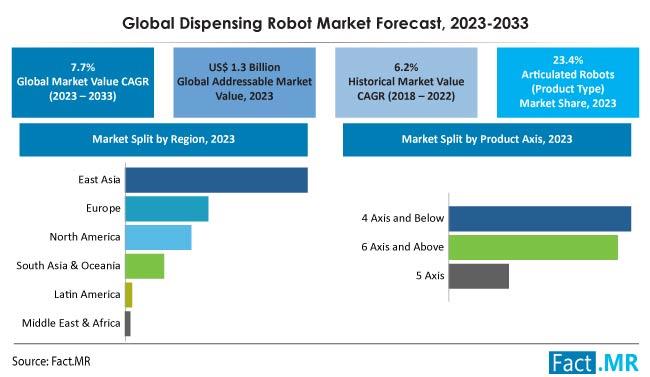(MENAFN- Ameliorate Digital Consultancy)
The Dispensing Robot Market is anticipated to be worth US$ 1.3 billion in 2023 and to grow at a CAGR of 7.7% to US$ 2.9 billion by the end of 2033. The value of the worldwide robot market is projected to be around US$38.6 billion in 2023. By the end of 2022, sales of dispensing robots held a nearly 3.6% market share worldwide.
In recent years, the global market for dispensing robots has experienced remarkable growth, with advancements in automation and robotics driving its expansion. Dispensing robots are robotic systems designed to precisely and accurately dispense various substances such as adhesives, sealants, coatings, lubricants, and other materials.
Download a Sample Copy of This Report –

These robots are revolutionizing industries by improving production efficiency, reducing material waste, and enhancing product quality. With their wide-ranging applications across multiple sectors, the dispensing robot market is witnessing a surge in demand and innovation.
Key Companies Profiled
ABB ESYS Automation Techcon Systems Everprecision Fanuc Fisnar, Inc. Iwashita Engineering Janome Kawasaki Robotics KUKA Mitsubishi Electric Musashi Nordson EFD Saejong Yaskawa Motoman
Growing Automation Trends
The increasing need for automation in industries such as automotive, electronics, healthcare, packaging, and aerospace is one of the primary factors propelling the growth of the dispensing robot market. These robots are capable of performing repetitive and precise tasks with high-speed and accuracy, surpassing human capabilities. By automating the dispensing process, manufacturers can achieve consistent results, eliminate human errors, and enhance overall productivity.
Improved Efficiency and Product Quality
Dispensing robots offer several advantages that contribute to enhanced efficiency and product quality. These robots can handle complex dispensing patterns, micro-deposits, and intricate designs with ease, ensuring uniformity and precision. They can precisely control the volume, speed, and direction of material deposition, resulting in minimal wastage and reduced costs. Moreover, dispensing robots can work continuously for extended periods, reducing downtime and increasing production output, ultimately boosting profitability.
Advancements in Technology
Technological advancements have been pivotal in driving the dispensing robot market forward. Manufacturers are incorporating innovative features such as vision systems, machine learning algorithms, and real-time monitoring capabilities into these robots, enabling them to adapt to changing production requirements and optimize their performance. The integration of artificial intelligence (AI) and Internet of Things (IoT) technologies has further empowered these robots with predictive maintenance capabilities, remote monitoring, and data-driven decision-making, leading to improved operational efficiency.
Expanding Applications
The applications of dispensing robots span across numerous industries, showcasing their versatility and adaptability. In the automotive sector, these robots are used for precise adhesive application in body assembly, bonding of windshields, and sealing of components, ensuring structural integrity and vehicle safety.
In electronics manufacturing, dispensing robots are employed for accurate deposition of conductive adhesives, solder paste, and encapsulants in the production of printed circuit boards (PCBs), semiconductor packaging, and mobile devices. In the healthcare industry, they find application in drug dispensing, precise filling of medical devices, and microfluidic processes. Additionally, industries such as aerospace, packaging, construction, and consumer goods are also adopting dispensing robots for their specific needs.
Regional Outlook and Market Projections
The dispensing robot market is witnessing significant growth across various regions. North America and Europe have traditionally been early adopters of automation technologies and have a well-established manufacturing base. Asia-Pacific, with its thriving industrial sectors and increasing investments in automation, is projected to witness substantial growth in the market. The market is also expanding in emerging economies such as India, Brazil, and Southeast Asian countries, driven by the rapid industrialization and the need for operational efficiency.
According to market research reports, the global dispensing robot market is expected to grow at a robust compound annual growth rate (CAGR) over the forecast period. Factors such as increased demand for customization, stringent quality standards, and rising labor costs are likely to fuel the adoption of dispensing robots further.
Get Customization on this Report for Specific Research Solutions:
Dispensing robots are revolutionizing industries by streamlining production processes, improving efficiency, and ensuring consistent product quality. With their ability to automate complex dispensing tasks, these robots are rapidly becoming an indispensable part of modern manufacturing.
The continuous advancements in technology and the expanding applications across various industries are driving the growth of the dispensing robot market. As industries worldwide recognize the benefits of automation, the future looks promising for this innovative sector, with endless possibilities for enhanced productivity and operational excellence.
Contact:
US Sales Office:
11140 Rockville Pike
Suite 400
Rockville, MD 20852
United States
Email:




















Comments
No comment